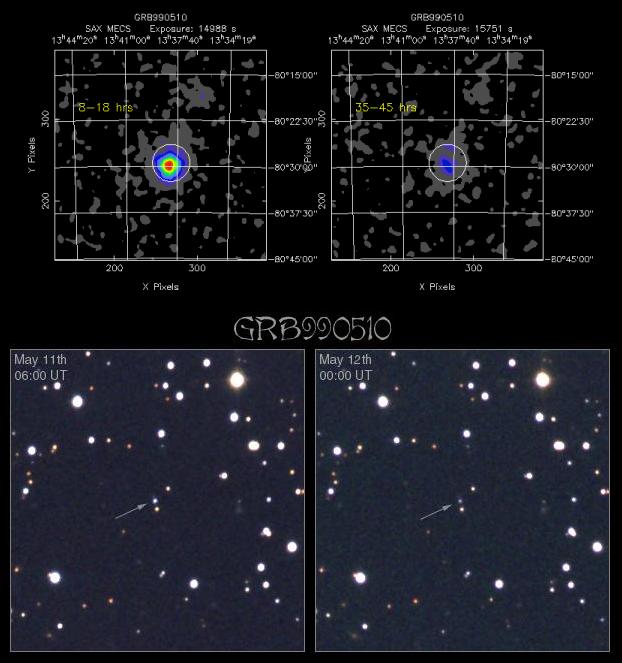
 Credit: X-ray: L. Piro and the BeppoSax Team; Optical:
J. Kaluzny
(Warsaw U. Obs.)
et al.,
1-meter Swope Telescope
Credit: X-ray: L. Piro and the BeppoSax Team; Optical:
J. Kaluzny
(Warsaw U. Obs.)
et al.,
1-meter Swope Telescope
Pinpointing an Elusive Burst
Gamma-Ray bursts are brief flashes of very high energy radiation; though
discovered by US military satellites (designed to detect high energy
evidence of Soviet nuclear tests) in the seventies, their origin remained a
mystery for more than 20 years, due to the fact that gamma-ray detectors
could not image the source of the bursts. A breakthrough came with the detection of
an X-ray "afterglow" of a gamma-ray burst by the BeppoSAX satellite in 1997.
Another breakthrough came with the detection of an "optical" afterglow of a
gamma-ray burst which occurred on May 5, 1999. An X-ray afterglow from the
"May Fifth" burst was detected by BeppoSAX, which transmitted the
approximate coordinates of the X-ray source to astronomers all around the
world. Astronomers trained their telescopes on this location, and an
object was detected which faded rapidly in brightness. The upper image
above shows the BeppoSAX image of the X-ray afterglow; the lower image
shows a photo of the region around the X-ray source, which clearly shows an
object which faded noticeably in brightness from May 11 to May 12. The
detection of this source by ground-based telescopes allowed astronomers to
pinpoint the location of the gamma-ray burst source; subsequent observation with the
Hubble Space Telescope showed the source to be located in a distant
galaxy and that the absolute power of the burst to be enormous - about as
bright as 10 billion Milky Way Galaxies!
Last Week *
HEA Dictionary * Archive
* Search HEAPOW
* Education
Each week the HEASARC
brings you new, exciting and beautiful images from X-ray and Gamma ray
astronomy. Check back each week and be sure to check out the HEAPOW archive!
Page Author: Dr. Michael F.
Corcoran
Last modified March 18, 2002


